Tekken
3
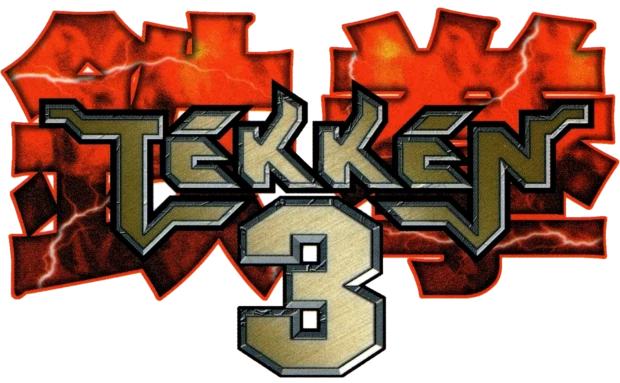
STORY:
Set fifteen years after the King of the
Iron Fist Tournament 2, the story starts with Jun Kazama, who has been living a
quiet life in Yakushima with her young son, Jin, who is the son of Kazuya
Mishima. Heihachi Mishima, meanwhile, has established the Tekken Force, an
organization dedicated to the protection of the Mishima Zaibatsu. Using the
company's influence, Heihachi is responsible for many events that have
ultimately led to world peace. However, while on an excavation in Mexico, a
squadron of Heihachi's Tekken Force is attacked and vanquished by a mysterious
being. The only surviving soldier manages to relay a brief message to Heihachi,
describing the perpetrator as an "Ogre" or a "Fighting God".
Heihachi and a team of soldiers investigate, with Heihachi managing to catch a
glimpse of the culprit. After seeing the Ogre character, Heihachi's long dormant
dream of world domination is reawakened. He seeks to capture Ogre to use him for
this goal.
Soon after, various martial arts masters begin
disappearing from all over the world, and Heihachi is convinced that this is
Ogre's doing. In Yakushima, Jun starts to feel the presence of Ogre approaching
her and Jin. Knowing that she has become a target, Jun tells Jin about Ogre, and
instructs him to go straight to Heihachi should anything happen. Sometime after
Jin's fifteenth birthday, Ogre does indeed attack. Against Jun's wishes, Jin
valiantly tries to fight Ogre off, but Ogre brushes him aside and knocks him
unconscious. When Jin reawakens, he finds that the house has been burned to the
ground, and that his mother is missing and most likely dead. Driven by revenge,
Jin goes to Heihachi and tells him everything. Jin begs Heihachi to train him to
become strong enough to face Ogre again. Heihachi accepts.
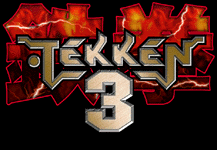
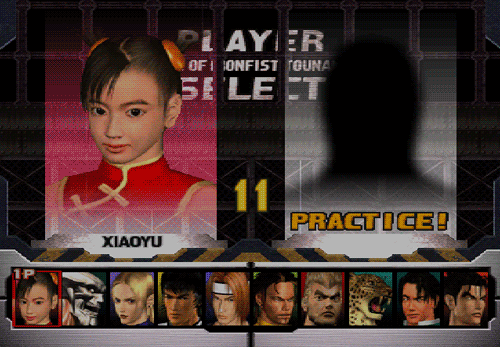
Three years later, Jin grows into an impressive
fighter and master of Mishima Style Karate. On Jin's nineteenth birthday, the
King of the Iron Fist Tournament 3 is announced, and Jin prepares for his
upcoming battle against Ogre. He is unaware, however, that Heihachi is merely
using him and the rest of the competitors as bait to lure Ogre out in order to
capture him. Eventually, the tournament leads to the final confrontation between
Jin and The God of Fight. Paul Phoenix was successful in defeating Ogre,
however, he leaves after winning the match. Unknown to him at the time, Ogre is
able to transform into a much more powerful "true" from, known to the
players as "True Ogre". When Jin arrives, he is confronted by this
True Ogre form and begins the fight. The battle rages for hours, until Jin
finally emerges the victor and Ogre completely dissolves. Moments later, Jin is
gunned down by a squadron of Tekken Forces led by Heihachi, who, no longer
needing Jin, finishes the job personally by firing a final shot into his
grandson's head.
However, Jin, revived by the Devil Gene within
him (because after Jin's mother had gone missing following an attack from Ogre,
Devil returned, branded Jin's left arm with a mark, possessing him), reawakens
and makes quick work of the soldiers, turning his attention to Heihachi and
literally smashing him through the wall of the temple. Heihachi survives the
long fall, but Jin, in mid-air, sprouts black, feathery wings and strikes
Heihachi one last time. He then flies off into the night, leaving his bewildered
grandfather staring after him.
|
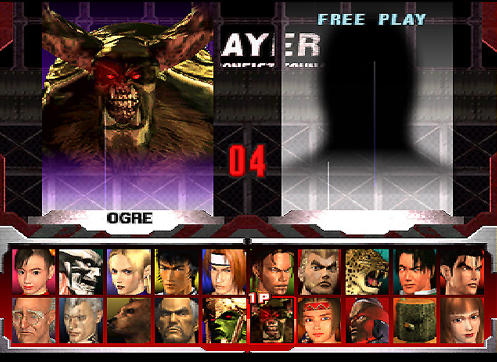
|
|
TEKKEN
3 character selection screen.
|
REVIEW: The third
installment to Namco's exciting martial arts-based 3D fighting game takes place an entire 15 years after the events of TEKKEN 2. Due to the new timeframe, many of TEKKEN's veteran warriors look noticeably older or matured, along with some "new blood" to spice up the roster. TEKKEN's gameplay hadn't changed a whole
lot from the first game to TEKKEN 2... but TEKKEN 3 introduced some
key gameplay elements that enhanced the experience,
including a now-staple 3D fighting game mechanic, the "sidestep".... Finally, TEKKEN not only
looked like a 3D fighting game, it actually played like one.
|
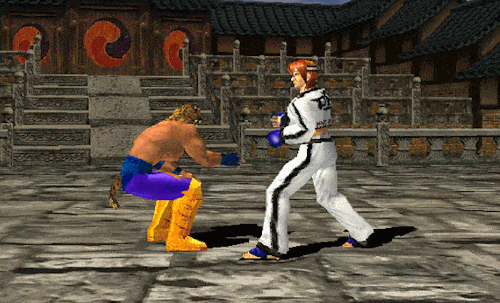
|
|
New tech like side-stepping
& counters
refined... and redefined gameplay.
|
Along with improved character
control and noticeably smoother animations, TEKKEN 3's sidestepping mechanic evolved the traditional "2D" aspect of fighting games. While using sidesteps properly required a "learning curve" for casual players... advanced players could now dodge opponents' attacks either by moving left or right, in addition to ducking high attacks
by crouching. Tapping "up" or "down" on the D-pad allows fighters to freely move around
the 3D environments and dodge their opponent's attacks (or projectiles) when timed properly. Of course, all returning characters received great updates to their movesets, including all new punch and kick counters (which require very strict timing). That means players who simply "button mash" in TEKKEN could easily be predicted and countered
by practiced players in all new ways!
The sidestep mechanic alone reinvented
TEKKEN's tried-and-true, previously combo-oriented gameplay engine - opening up new movement strategies and concepts such as beautifully-animated "Side Throws". Side Throws differ in animation depending on whether the opponent is thrown on their left or right side, and are completely unique for each character. No doubt, these new throws were some of the coolest-looking throw animations ever seen in a fighting game. Of course, fighters can also now "launch" their opponents from the side and perform
unique air
combos (including some specific combos that only work on the side or from behind). These deeper technical aspects of TEKKEN 3's gameplay made the game stand out to competitive players, as other 3D fighting games weren't even attempting this level of gameplay depth. The innovative sidestep system would be refined and fleshed out further in
future TEKKEN installments.
|

|
|
Beautiful
throw Animations for days. . .
|
Now that the core gameplay was
evolving from a 2D plane into a 3D plane, the character
development was also able to take a noticeable step forward.
Several intricately-designed new fighters have joined the cast, each representing their
own unique brand of authentic martial arts... and also highlight the new "3D movement" of the game. Newcomers include a young Tae
Kwon Do expert Hwoarang,
a cool Capoeira martial artist Eddy Gordo,
and a fast and agile Chinese female, Ling Xiaoyu. Last but not least, Jin Kazama takes the place of his father, Kazuya, fighting
very similarly to his old man but featuring his fair share of unique attacks and clearly doing this "his way". Even
though several characters from the prequels were sadly missing-in-action, TEKKEN 3's roster was the most diverse and perhaps most balanced to date, with all characters offering very different styles of fighting (especially in the hands of a skilled player).
|
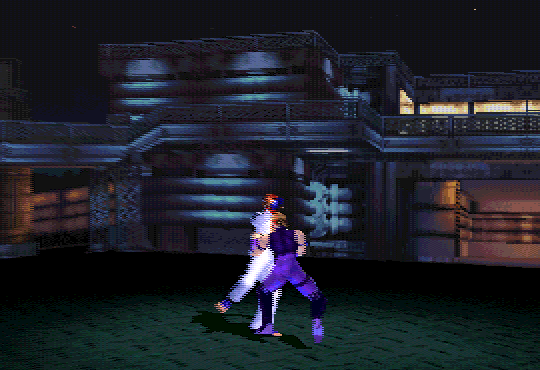
|
|
Nina
learning
Tae Kwon Do the hard way.
|
The console version of TEKKEN 3 wasn't simply an "arcade port"... which was the expected standard when an arcade fighting game released on console. The PS1 version of TEKKEN 3 actually had several exciting additions over the arcade version, including fully-animated FMV character endings (which rocked), and new modes
such as TEKKEN Ball (a volleyball type game where you can use any of the
characters) and TEKKEN Force mode (a 2D beat-em-up style game with four levels).
These bonus modes were incredibly innovative modes for a fighting game at the time, offering a nice change of pace from the usual 1-vs-1 fighting. Also included in the home package is Team Battle mode - enabling up to 8 fighters on each player's team, and a Music Gallery where you can listen to Arcade and Console version tracks for every character. All in all, TEKKEN 3
innovated console fighting games at the time with its polished gameplay and console-exclusive bonus features.
 FUN FACT:
The
PlayStation 1 version of TEKKEN 3 sold over 8.3 million
copies, making it one of the best-selling fighting games of the time period (and
all time). TEKKEN 7
would eventually surpass TEKKEN 3's
milestone in total sales, selling over 10
million copies worldwide since the console version launch in June 2017. FUN FACT:
The
PlayStation 1 version of TEKKEN 3 sold over 8.3 million
copies, making it one of the best-selling fighting games of the time period (and
all time). TEKKEN 7
would eventually surpass TEKKEN 3's
milestone in total sales, selling over 10
million copies worldwide since the console version launch in June 2017.
|
|

| Page Updated: |
September
25th, 2025
|
| Developer(s): |
Namco |
| Publisher(s): |
Namco |
| Designer(s): |
Masahiro
Kimoto Director
Katsuhiro Harada Director
Hijame Nakatani Producer
|
| Platform(s): |
Arcade,
PlayStation, Dreamcast, PSN
|
| Release Date(s): |
Mar. 20th, 1997 Arcade
Mar. 26th, 1998
 PS1 PS1
Apr. 29th 1998  PS1 PS1
Sept. 12th, 1998  PS1 PS1
Oct. 31st, 2001 Dreamcast - via Bleemcast!
Dec. 21st, 2001  PS1 PS1 |
| Characters: |
Jin
Kazama,
Ling Xiaoyu, Eddy
Gordo,
Hwoarang, Forest Law,
Lei
Wulong, King,
Nina Williams,
Julia
Chang,
Paul Phoenix,
Yoshimitsu,
Gun
Jack, Kuma,
Panda,
Bryan Fury, Ogre,
Anna Williams,
Tiger,
True
Ogre, Heihachi Mishima, Dr. Boskonovitch, Gon, Mokujin |
| News
Links: |
Sep.
2025: SoulCalibur III, TEKKEN 3 Coming to PS5 / PS4 |
|
|
|
Featured Video:
|
|
|
| Related Games: |
TEKKEN
Tag Tournament, TEKKEN 4, TEKKEN,
TEKKEN 2, TEKKEN
Advance, TEKKEN 5, TEKKEN
5: Dark Resurrection,
TEKKEN 5: Dark Resurrection Online, TEKKEN: Dark Resurrection,
TEKKEN 6, TEKKEN 6:
Bloodline Rebellion, TEKKEN Tag Tournament 2, TEKKEN
7,
TEKKEN 7: Fated Retribution, TEKKEN
8, TEKKEN Revolution,
TEKKEN Hybrid,
TEKKEN 3DS: Prime Edition, Street Fighter X
TEKKEN, Virtua Fighter 3, Bloody
Roar, Soul Blade,
Soul Calibur,
Ehrgeiz: God Bless The Ring,
Tobal No. 1,
Tobal 2 |
|

|
|
Gameplay
Engine
|
9.5 / 10
|
|
Story
/ Theme
|
9.5 / 10
|
|
Overall
Graphics
|
9.0 / 10
|
|
Animation
|
9.0 / 10
|
|
Music
/ Sound Effects
|
9.0 / 10
|
|
Innovation
|
9.0 / 10
|
|
Art Direction
|
9.0 / 10
|
|
Customization
|
8.0 / 10
|
|
Options / Extras
|
10 / 10
|
|
Intro / Presentation
|
10 / 10
|
|
Replayability / Fun
|
9.0 / 10
|
|
"Ouch" Factor
|
9.5 / 10
|
|
Characters
|
9.5 / 10
|
|
BOTTOM LINE
|
9.6
/
10
|
|
Review based on Arcade / PS1 version
|
|
| Final
Words: |
Without a doubt,
TEKKEN 3 was one of the most influential 3D fighting games of the era... innovating in terms of presentation, character development, and gameplay. The arcade version was a huge hit among arcade-goers of the late 90's, but the PS1 version of TEKKEN 3 knocked it out of the park with impressive "arcade quality" graphics,
console-exclusive bonus modes, brand new character FMV ending movies, and many extra options (including the best in-game music player to date). Best console fighting game in 1998? Yes. Just yes.
TEKKEN 3 was a reason to be "proud" to be playing fighting games at home in 1998... because if you weren't playing it on you overheating PS1, you were seriously missing out on some fun (and possibly experience that would pay off later down the road). TEKKEN 3 raised the bar for fighting games. Not only did TEKKEN 3 improve its own tried-and-true gameplay elements
introduced in the first two games, it expanded the environment intro a true "3D-feeling" one with the introduction of the raw sidestep technique. Presentation-wise,
TEKKEN 3 made a huge impact even among mainstream reviewers and casual players. Most importantly, TEKKEN 3's gameplay system was fun, easy-to-get into, yet solid (albeit slightly unbalanced), paving
the way for a plethora of successful sequels.
TEKKEN 3's intro cinematic on PS1 is still among my favorite video game intros of all time.
It flows brilliantly from beginning to end... the music and cinematics blended seamlessly. TEKKEN 3's modern and incredibly well-done intro defined the forward direction fighting games were headed in at the time. The characters of TEKKEN saw a drastic evolution in terms of appearance and larger movesets, demonstrating their authentic martial arts styles
more impressively than ever before. The FMV character endings were
equally impressive, fleshing out TEKKEN's amazing roster to new heights.
In retrospect:  Some nostalgic fans are known for saying things like "TEKKEN 3 was the pinnacle / best of the series"... and in terms of presentation, it's up there. However, a fighting game is so much more than a good intro. If you think TEKKEN 3 is "as good as TEKKEN gets," you're
sorely mistaken (and missing out on gameplay depth that the later installments introduce). TEKKEN
3 was actually pretty unbalanced in terms of gameplay and had many broken combos. That said, I implore old school (casual) fans to take off their "nostalgia glasses" and actually learn how to play modern TEKKEN, like
TEKKEN 7. Some nostalgic fans are known for saying things like "TEKKEN 3 was the pinnacle / best of the series"... and in terms of presentation, it's up there. However, a fighting game is so much more than a good intro. If you think TEKKEN 3 is "as good as TEKKEN gets," you're
sorely mistaken (and missing out on gameplay depth that the later installments introduce). TEKKEN
3 was actually pretty unbalanced in terms of gameplay and had many broken combos. That said, I implore old school (casual) fans to take off their "nostalgia glasses" and actually learn how to play modern TEKKEN, like
TEKKEN 7.  The improved balance, animations, deeper movesets,
and heavily refined gameplay mechanics should not be missed. In fact, old school TEKKEN players will be able to appreciate the evolutions of the series even more than others! The improved balance, animations, deeper movesets,
and heavily refined gameplay mechanics should not be missed. In fact, old school TEKKEN players will be able to appreciate the evolutions of the series even more than others!
Two years after TEKKEN 3 hit arcades, a sequel based on TEKKEN 3's engine, TEKKEN Tag Tournament (and future smash hit on PS2) was released. TEKKEN Tag Tournament used an upgraded gameplay system based on TEKKEN 3's, innovating with 2-vs-2 tag team gameplay, and added many fan-favorite characters who went missing in TEKKEN 3.
~TFG
Webmaster | @Fighters_Gen
|
|
|
|
|
|
|
|
|
|
|
|
|
|
|
|
|